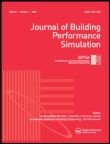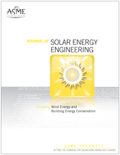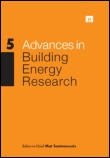
Building Simulation
Scope & Guideline
Empowering Sustainable Design Through Simulation
Introduction
Aims and Scopes
- Building Energy Performance:
Focuses on optimizing energy use in buildings through simulations that analyze energy consumption, efficiency measures, and renewable energy integration. - Indoor Environmental Quality (IEQ):
Researches factors affecting indoor environments, such as air quality, thermal comfort, and acoustic performance, utilizing simulation tools to enhance occupant health and comfort. - Ventilation and Airflow Dynamics:
Explores the dynamics of airflow in buildings, assessing ventilation strategies and their effectiveness in controlling pollutants and providing comfort. - Simulation Methodologies and Tools:
Develops and evaluates new simulation tools and methodologies that improve the accuracy and reliability of building performance predictions. - Sustainable Design and Retrofit Strategies:
Investigates energy-efficient design strategies and retrofitting techniques aimed at reducing the carbon footprint of existing buildings. - Climate Adaptation and Resilience:
Analyzes how buildings can adapt to changing climate conditions, focusing on strategies that enhance resilience against extreme weather events.
Trending and Emerging
- Machine Learning and AI in Building Simulation:
The integration of machine learning and artificial intelligence techniques is increasingly being utilized for predictive modeling, fault diagnosis, and optimization of building energy systems. - Smart Building Technologies:
Research on smart building technologies, including IoT devices and automated control systems, is gaining momentum, focusing on enhancing energy efficiency and occupant comfort. - Health and Wellbeing in Building Design:
There is a growing emphasis on health and wellbeing in building design, with research exploring how building environments affect mental and physical health, particularly in the context of post-pandemic recovery. - Resilient and Adaptive Design:
Emerging themes focus on designing buildings that can adapt to climate change, including strategies for energy efficiency and resilience to extreme weather events. - Data-Driven Decision Making:
The use of big data analytics and cloud computing for real-time monitoring and optimization of building performance is increasingly trending, enabling smarter energy management practices.
Declining or Waning
- Traditional HVAC Systems:
Research on conventional HVAC systems is declining as newer technologies and smart systems are increasingly being developed, emphasizing energy efficiency and occupant-centric designs. - Static Building Design Approaches:
There is a waning interest in static design methodologies that do not account for dynamic factors such as occupant behavior and environmental changes, as adaptive and responsive designs gain traction. - Generalized Energy Modeling:
The focus on broad, generalized energy modeling without specific contextual applications is diminishing, with a shift towards more detailed, case-specific studies that incorporate local climate and building types. - Single-Factor Performance Metrics:
The reliance on single performance metrics for assessing building efficiency is decreasing, as multi-faceted approaches that consider various interrelated factors are becoming more prevalent. - Conventional Materials and Techniques:
Research into traditional building materials and construction techniques is declining, as innovative materials and construction methods that support sustainability and energy efficiency are increasingly favored.
Similar Journals

BUILDING ACOUSTICS
Decoding the Science of Sound in StructuresBuilding Acoustics, published by SAGE Publications Inc, is a distinguished journal that serves as a critical resource in the fields of acoustics, building construction, and mechanical engineering. With an ISSN of 1351-010X and an E-ISSN of 2059-8025, this journal has maintained a strong reputation since its inception in 1997, featuring rigorous peer-reviewed research that provides valuable insights into the acoustic properties of buildings and environments. With a commendable Q2 ranking in its categories and a notable standing within the Scopus Ranks, this journal plays a pivotal role in advancing knowledge and practice in its field. Researchers, professionals, and students are invited to engage with cutting-edge studies that address crucial aspects of sound control, environmental noise, and sustainable architectural design. Although not an Open Access journal, Building Acoustics ensures accessibility through various institutional affiliations and library provisions, solidifying its position as an essential publication for those dedicated to enhancing the acoustic performance of built environments.

Russian Journal of Building Construction and Architecture
Connecting Theory and Practice in Sustainable DevelopmentRussian Journal of Building Construction and Architecture (ISSN: 2542-0526; E-ISSN: 2542-0526), published by the esteemed Voronezh State Technical University, serves as a vital platform for disseminating innovative research and practical applications in the fields of building construction and architecture. This journal, situated in Voronezh, Russia, aims to explore both the theoretical and empirical aspects of contemporary architecture and construction practices, fostering a robust dialogue among researchers, professionals, and academics. With an emphasis on open access to knowledge, the journal significantly contributes to global discourse by ensuring that findings are accessible to a wide audience. Underlining the importance of sustainable development and cutting-edge technologies in construction, the journal strives to publish high-quality research that addresses the challenges faced in today’s building environment, making it an invaluable resource for those committed to advancing the industry.

Revista Habitat Sustentable
Advancing Sustainable Solutions for Our Built EnvironmentRevista Habitat Sustentable, published by UNIV BIO-BIO in Chile, is a dynamic open access journal that has been contributing to the fields of architecture, engineering, and sustainable development since its establishment in 2011. With an ISSN of 0719-0700, this scholarly platform stands out for its commitment to disseminating high-quality research that addresses pressing issues in sustainability and urban planning. Currently, it holds commendable rankings in several categories, including Q2 in Architecture and Q3 in Urban Studies, reflecting its growing influence and outreach across various disciplines. The journal's mission is to foster interdisciplinary dialogue and encourage innovative approaches to habitat sustainability, making it an essential resource for researchers, professionals, and students engaged in addressing the complex challenges of our built environment. Accessible to a global audience, the Revista Habitat Sustentable is poised to play a pivotal role in shaping future research and policy in sustainable living and development.

Journal of Building Performance Simulation
Transforming Building Performance with Cutting-Edge MethodologiesJournal of Building Performance Simulation, published by Taylor & Francis Ltd, is a premier academic journal dedicated to advancing the fields of architecture, building and construction, and computational modeling. With an ISSN of 1940-1493 and an E-ISSN of 1940-1507, this journal is recognized for its high-quality, peer-reviewed research, reflected in its impressive Q1 ranking in both Architecture and Building and Construction categories for 2023. Spread over a notable converged publishing timeline from 2008 to 2024, it aims to address contemporary issues in building performance and simulation methodologies, serving both practitioners and academics alike. Positioned within the 92nd percentile in Engineering - Architecture, the journal is a vital resource for professionals focused on innovative design and simulation technologies that enhance building efficiency and sustainability. Despite its robust reputation, the journal currently does not offer open-access options, which underscores its commitment to maintaining academic rigor. Engage with cutting-edge research that drives the future of building performance through this influential journal.

INDOOR AND BUILT ENVIRONMENT
Transforming Built Environments for Better LivingINDOOR AND BUILT ENVIRONMENT is a prestigious peer-reviewed journal published by SAGE PUBLICATIONS LTD, focusing on the interdisciplinary fields of indoor environmental quality, human health, and sustainable built environments. With an ISSN of 1420-326X and an E-ISSN of 1423-0070, the journal has been a significant contributor to research and knowledge dissemination since its inception in 1992, continuing through to 2024. Positioned in the Q2 category of public health, it ranks impressively at #122 out of 665 in the Scopus metrics for Medicine, showcasing its influence and relevance in the field with an 81st percentile standing. While the journal does not currently offer open access options, it remains a vital resource for researchers, professionals, and students eager to explore the critical interplay between indoor environments and public health. With its comprehensive coverage and a commitment to high-quality research, INDOOR AND BUILT ENVIRONMENT plays an essential role in advancing knowledge and practices that contribute to healthier living and working spaces.

JOURNAL OF SOLAR ENERGY ENGINEERING-TRANSACTIONS OF THE ASME
Pioneering Research for a Sustainable Energy Future.JOURNAL OF SOLAR ENERGY ENGINEERING-TRANSACTIONS OF THE ASME is a premier publication dedicated to advancing the field of solar energy engineering, under the auspices of the prestigious American Society of Mechanical Engineers (ASME). With the ISSN 0199-6231 and E-ISSN 1528-8986, this journal has established itself as a critical resource for researchers and professionals alike, particularly in the areas of energy engineering and renewable technology. Currently enjoying an impact factor that places it in the Q2 category for Energy Engineering and Power Technology and Q3 for Renewable Energy, Sustainability, and the Environment, this journal effectively bridges impactful research and practical application. Spanning contributions from 1980 to 2025, the journal emphasizes empirical studies, innovative methodologies, and sustainable solutions that resonate with the growing global demand for renewable energy. The journal’s commitment to quality is reflected in its competitive Scopus rankings: 97th out of 272 in Energy Engineering and 124th out of 270 in Renewable Energy. Although not an Open Access journal, it remains a vital forum for disseminating research that shapes our energy future. Located in New York, this journal serves as a cornerstone for those in academia and industry to stay abreast of the latest advancements in solar energy technologies and their application in sustainable development.

Advances in Building Energy Research
Empowering Sustainable Futures in Building EnergyAdvances in Building Energy Research is a pivotal journal dedicated to the scholarly exploration of energy efficiency and sustainable practices within the building and construction sector. Published by Taylor & Francis Ltd from the United Kingdom, this journal provides a rich platform for researchers, industry professionals, and students interested in the latest advancements and methodologies that drive energy conservation in architecture and engineering. With an impressive 2023 Scopus ranking of #64 out of 223 in the Building and Construction category and a notable Q2 category quartile, the journal occupies a significant position in its field, emphasizing high-quality, peer-reviewed research that meets the needs of a global audience. Though it operates under a subscription model, its contributions are invaluable for advancing knowledge that addresses the urgent challenges of energy consumption and sustainability in built environments. Spanning research published from 2007 to 2024, this journal continues to be an essential resource for those seeking innovative solutions and insights into building energy performance.

International Journal of Air-Conditioning and Refrigeration
Innovating Cooling Solutions for a Sustainable FutureInternational Journal of Air-Conditioning and Refrigeration is a leading peer-reviewed journal published by SpringerNature, focusing on pioneering research in the fields of air-conditioning and refrigeration technologies. With an Open Access model adopted since 2022, the journal ensures that high-quality research is freely accessible to a broad audience, facilitating knowledge dissemination and innovation. The journal covers a diverse range of topics, including control systems, fluid flow, and renewable energy applications, making it relevant for professionals and researchers within the disciplines of Control and Systems Engineering, Fluid Flow and Transfer Processes, and Renewable Energy. Positioned in the Q3 quartile across multiple categories as of 2023, it offers a valuable platform for emerging trends and sustainable practices in the industry. The Scopus rankings reflect its commitment to scholarly excellence, highlighting its role as an essential resource for those engaged in the development and implementation of innovative air-conditioning and refrigeration systems.

Intelligent Buildings International
Pioneering the Future of Smart Building TechnologiesIntelligent Buildings International, published by Taylor & Francis Ltd, is a premier journal dedicated to advancing knowledge in the interdisciplinary domains of building construction, civil engineering, computer science applications, and planning. Since its inception in 2009, this journal has become a vital resource for researchers, professionals, and students, offering a platform for high-quality scholarly articles that explore innovative strategies and technologies in intelligent building design and efficiencies. With its significant impact factor reflected in its Q2 and Q3 quartile rankings across various related fields, and strong Scopus rankings placing it among the top journals in Geography, Building, and Civil Engineering, Intelligent Buildings International stands out for its commitment to fostering research that enhances the sustainability and functionality of contemporary architectural practices. Readers can access a wealth of articles that illuminate the complexities of smart building technologies and their implications for future construction practices, making it an essential addition to any academic library.

Buildings
Connecting Disciplines for a Sustainable Built EnvironmentBuildings is a premier peer-reviewed journal published by MDPI, focusing on the multidisciplinary aspects of architectural and civil engineering. Established in 2011, this Open Access journal has quickly gained recognition in the academic community and is currently classified in the Q1 category for Architecture and Q2 for Building and Construction, as well as Civil and Structural Engineering, reflecting its significant impact within these fields. With Scopus rankings placing it in the top tier of architecture and construction disciplines, Buildings provides a platform for innovative research and practical applications that push the boundaries of knowledge in building design, sustainability, and infrastructure development. The journal, based in Switzerland and intended for an international audience, welcomes various types of content including research articles, reviews, and case studies, ensuring a comprehensive resource for researchers, professionals, and students alike.